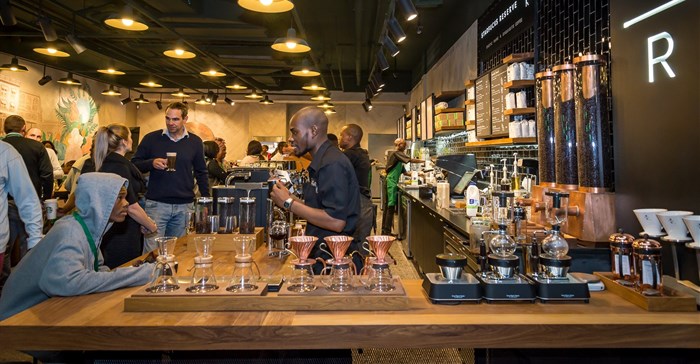Taste Holdings has released its interim results to August 2016, which show the South African-based management group has experienced significant gains in its licensed brand strategy, as the Domino's Pizza business settles down and Starbucks Coffee draws consumer interest.
Taste CEO, Carlo Gonzaga, says Domino’s has experienced a 17% average weekly sales rise since March, while the three Starbucks stores have traded well ahead of the original investment cases and forecasts. In the four month of trading, the Rosebank and Mall of Africa stores falling into this period under review produced a combined revenue of R18m and are already producing positive four-wall earnings before interest, taxes, depreciation and amortisation (EBITDA), despite the expected control challenges inherent in a new business. (Four-walls refers to the direct revenues and costs associated with an individual store.)
Taste opened a third store in Menlyn Maine, Pretoria in September 2016.

The recently opened Starbucks Menlyn Maine store in Pretoria also serves the Starbucks Reserve brand, meaning South Africa is among the less than 2% of Starbucks stores globally offering the micro-lot and exclusive coffees specifically roasted in Seattle.
Taste owns and licenses a portfolio of franchised and owned, category specialist and formula-driven quick service restaurants (QSR), coffee and luxury retail brands, housed within the food and luxury goods divisions. The group is strategically focused on licensing leading global brands; leveraging scale among its low-cost food brands; increasing ownership of corporate-owned stores across both divisions and supporting this growth through a vertically integrated platform.
The luxury goods division, the stewards of brands such as Rolex, Omega, Hublot, Breitling, Rado, TAG Heuer and Longines Swiss watches and, more recently, Cartier, IWC and Montblanc watches and writing instruments, achieved a same-store sales growth of 25%.
Gonzaga says investment into executive capacity in the past year has been the driving force behind management’s ability to launch two globally leading food brands almost simultaneously.
“The Starbucks launch has been lauded by Starbucks internationally and we can proudly say we have already set records within this globally admired brand. Yet, both Starbucks and Domino’s combined are less than two years old in South Africa and are essentially start-up businesses,” he says.
During the period under review, Taste opened two Starbucks outlets in April; finalised, bar two, the Domino’s conversion from Scooters Pizza and St Elmo’s Pizza outlets; extended the scale of the food distribution business by including the Starbucks products; turned the locally owned business to positive same-store sales among the three brands and extended its luxury watch brand representation through an additional Rolex outlet in Mall of Africa and adding Cartier, IWC and Montblanc to the existing stable.
Group system-wide sales rose 7.4% to R858m, translating into a 15% core revenue increase to R519m. There was an additional R18m core gross margin compared to the corresponding period, a 10% hike.
Gonzaga says typical to start-up businesses, the exceptional earnings in the jewellery division was counterbalanced by the food division investments – most obviously reflected in the higher operating costs.
Taste recorded a R10m loss (2015: R17.5m profit) for the period, translating into a 6.1c (0.1c profit) headline loss per share.
Food portfolio appeals across income levels
The diversified brand portfolio within the food division appeals to middle and upper-income consumers in Starbucks, Domino’s and Maxi’s and lower-income consumers via Zebro’s Chicken and The Fish & Chip Co.
Same-store sales in Maxi’s rose 3% following a similar increase in the preceding six months.
Same-store sales in The Fish & Chip Co. business “pleasingly remained positive” every month to end 5% higher than the corresponding period. Zebro’s Chicken continued performing positively, albeit more slowly, and ended 1.5% higher than the prior period, but lower than the 9,5% increase achieved for the same period a year ago.
Domino’s ended the period with 85 outlets against the 74 held at year-end in February and since the half-year, has opened another two outlets. Currently Taste owns 31 outlets with the balanced being franchised.
“The shift in focus from conversions to driving the existing business is bearing fruit with sales in Domino’s increasing steadily since March and currently 17% above that level,” Gonzaga says.
He says management has applied the lessons learnt in bedding down Domino’s, to Starbucks and those stores are already showing gross profit at store level despite the expected inefficiencies on launch.
South Africa serves Starbucks Reserve brand
The Menlyn Maine, Pretoria store also serves the Starbucks Reserve brand meaning South Africa is among the less than 2% of Starbucks stores globally offering the micro-lot and exclusive coffees specifically roasted in Seattle. Management is still estimating opening 12 to 15 Starbucks stores in the first two years.
Same-store sales in the luxury goods division rose 25%, which, combined with new store growth, resulted in a system-wide sales hike of 29% to R316 million.
Gonzaga says these growths followed a 12-month same-store sales increase of 15%, presenting an enormous challenge to anniversary these increases in coming periods.” However, the luxury goods division historically produces 70-75% of its full-year profits in the second half-year.
He says while Taste was still on track to achieve breakeven on the Starbucks business by store five, management acknowledges the short-term earnings will remain under pressure as the group commits to the growth potential these leading brands have locally.
Consequently, management will continue focussing inward to unlock those potential opportunities as they currently also represent the best available return on capital in the market.
In line with company policy, Taste does not declare an interim dividend.






























